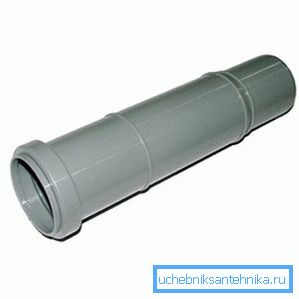Adapters for sewer pipes and their types
When installing a sewer pipeline, there is often a need for joining components of different diameters or elements made of different materials. This problem can be solved with the help of adapters (fittings), which allow you to safely and tightly mount any nodes. In this article we will look at what sewer adapters exist and in what situations they are used.

Types of adapters
As mentioned above, all existing adapters for pipes for sewage are of two types:
| For the connection of components of different sections | The ends of such a product have a different diameter. |
| For the connection of components made of different materials. | The main task is to ensure the tightness of the joint. The most common sewer transition from cast iron to plastic. |
Now let's take a closer look at the features of both types of fittings.

Connection of elements of different diameter
In most domestic sewer systems, pipes with a cross section of 110 mm and 50 mm are used. There are several types of fittings for connecting them.
Note! In the course of sewage drains the diameter of the pipeline can only be increased, but not reduced. Otherwise, the probability of blockages will increase dramatically.
In practice, for this purpose most often used:
- Smooth products that provide a direct transition from a diameter of 50 mm to 110 mm. People call them “bottles” because they have a shape similar to a bottle. On the market you can find such adapters for plastic sewer pipes and cast iron systems.
- Swivel, providing not only the transition from one diameter to another, but also changing the direction of waste. As a rule, these are standard crosses and tees with a section of 110 mm, which have one or two branches per 50 mm.

All adapters for plastic sewers involve the use of rubber sealing rings to ensure the tightness of the joints. Cast-iron fittings are mounted with staking, like other components of cast-iron sewers.
Compound elements from different materials
When repairing or replacing sewage drainage systems in an apartment, plumbers often have to deal with the need to connect a cast-iron riser with plastic. In this case, the cuff is used, i.e. special rubber adapter for sewage, which provides a tight fit to the materials.

Cuffs come in various designs:
- Internal - are installed in the socket of a cast-iron pipe, as a result of which they allow you to connect a plastic pipe of various diameters to it. The external section of such a product should correspond to the diameter of the socket, the internal one can vary depending on the section of the plastic pipe. I must say that such cuffs are also used to connect the drain of household appliances with a corrugated hose, in particular, such an adapter is suitable for connecting the washing machine to the sewage system.
- Outdoor plastic - used in cases when you need to connect to a socketless pipe.

To connect the components using such cuffs is not difficult.
In the first case, the instruction looks like this:
- First of all, the bell must be cleaned of cement mortar (embossing mixture).
- Then on the outside of the cuff should be applied a layer of silicone sealant.
- Further, the product can be inserted into the socket. After curing the sealant, a reliable joint is obtained. On the inner side of the sealant can not be applied.
When working with the outer cuff, you need to perform the following actions:
- A sealant is applied to the internal surface of the fitting,
- Then he puts on a cast iron pipe.
- After the sealant has set, a plastic pipe is connected.
Note! Align the pipe cut before installation. The edge should not have irregularities, otherwise in this place the removal of drains will be regularly clogged.
Compensator
Sometimes there are cases when it is not possible to completely replace the sewer system, since the cost of repairs will be quite high. In this case, perform a partial replacement, which would require the use of a compensator.

This element is a small length of pipe, having an enlarged bell. Due to the large socket, the inserted element can move along the line axis. Thus, you can easily combine a new sewer with the remaining elements.
Installation of the riser with their own hands using a compensator is performed as follows:
- The rubber cuff is inserted into the cast-iron socket.
- After that, a compensator is inserted and the pipe to be mounted is cut to the required size.
- Then the installed part is pressed all the way into the compensator socket, as a result, its upper part should be leveled with the upper part of the pipeline.
- Further, the pipe gradually extends from the compensator and is put on the upper section of the pipeline. The result is a holistic design.
In most cases, using a compensator is the only possible way to perform a partial replacement of the riser.
Conclusion
We considered all the main types of fittings and cuffs, which is enough to perform both partial and full replacement of the pipeline in a house or apartment. At observance of technology of their installation, a fitting provide reliable tight joints of component parts, regardless of their section and material. From the video in this article, you can get more information on this topic.